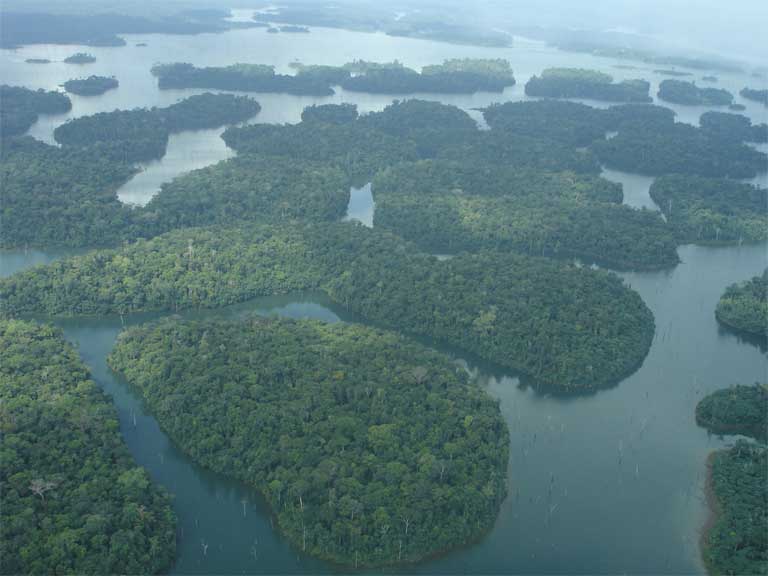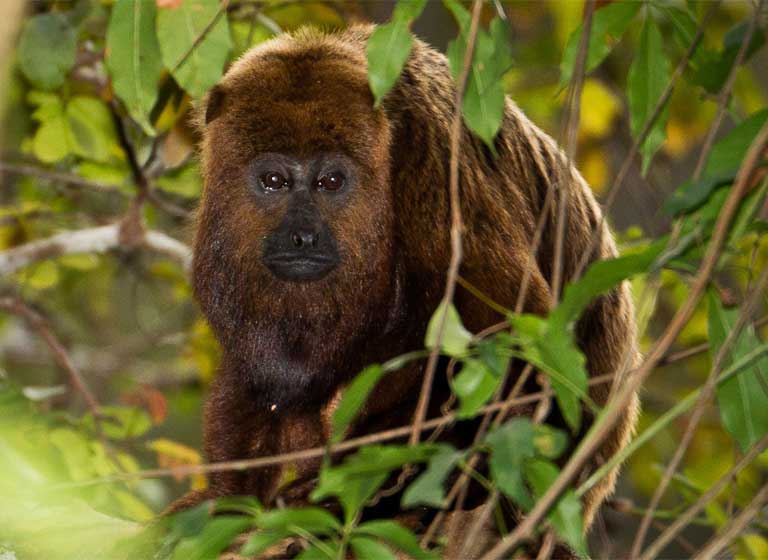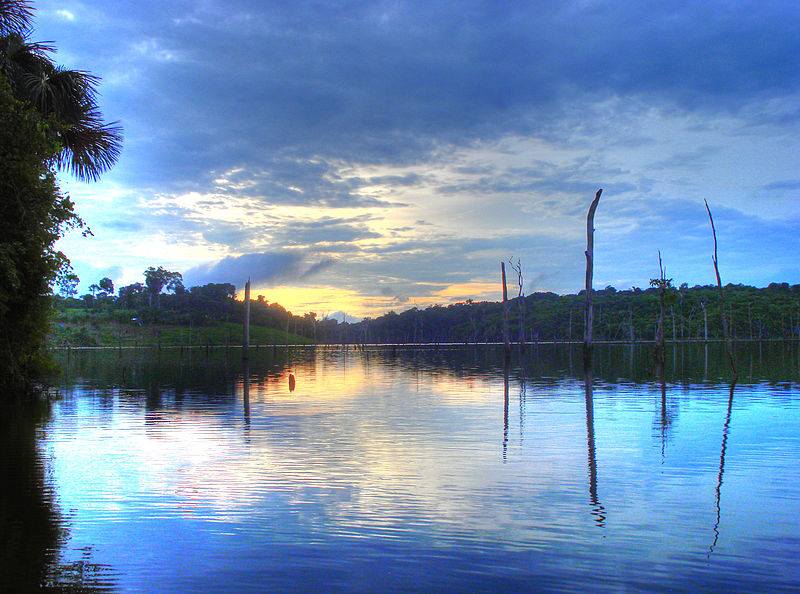- There’s a wealth of evidence from around the world that tropical hydroelectric dams and their gigantic reservoirs do tremendous harm to aquatic and terrestrial biodiversity.
- 43 large dams are planned for the Amazon’s Tapajós River Basin, with hundreds more being considered for the rest of the Amazon. A study of the 30-year-old Balbina dam found that biodiversity plummeted after it was built.
- The challenge in the Amazon, with the recent onslaught of so many new dam projects, is to gather baseline wildlife data, study potential habitat impacts, and find solutions to be included in project designs to protect animals — a near impossibility when governments, like that of Brazil, act in secrecy and largely fail to work with researchers.

When the Balbina Dam was completed in 1987, it flooded primary forest in the state of Amazonas along Brazil’s Uatumã River, forming a massive reservoir speckled by 3,546 flood-induced islands.
In 1990, the Reserva Biológica (REBIO) do Uatumã was established, protecting the entire 443,700 hectare (109,6427 acre) reservoir, dubbed Balbina Lake, along with the adjacent mainland — the largest such reserve in the country at around 940,000 hectares (232, 2834 acres).
But nearly three decades on, science has shown that these protective measures haven’t helped most species much — if at all. That discovery by researcher Maira Benchimol and her colleagues could have major repercussions for the 43 large dams planned for the Amazon’s Tapajós River Basin, and for hundreds of other proposed tropical dams throughout Latin America.
Benchimol, an environmental scientist focused on ecology and conservation, did her graduate work at the University of East Anglia, and has now done groundbreaking research on the impacts of Balbina’s fragmented habitats on wildlife.
She began by studying primates in 2009; animals that especially suffer after water isolation due to poor swimming skills. Then she became curious as to how other Amazonian life was faring on the forested islands of the reservoir.

Under the supervision of the University’s Carlos Peres, Benchimol spent from June 2011 to December 2012 observing the prevalence of diurnal and nocturnal, large to mid-sized vertebrate species, found on the forest floor or in the canopy. She used field techniques that included camera traps, or looking for animal-evidence such as seed casings and digging patterns.
She considered 35 species — a mix of mammals, birds and tortoises — on 37 various-sized islands and 3 continuous forest sites in the adjacent protected reserve for comparison. The results were clear: smaller islands that Benchimol sampled had lost most of their biodiversity, and by extrapolating this extinction-to-island-size rate to all Balbina islands, she concluded most have likely lost 70 percent of the species included in the study.
“My general conclusion?’’ she says.“Don’t create islands.”
With so many dams planned for the Tapajós Basin and beyond, what kind of wildlife and habitat losses can be expected if these projects go forward? Researchers at the heart of the Amazon dam-debate weigh in here on the matter, outlining the challenges they think Tapajós wildlife could face, as well as approaches that could help avoid the localized extinctions Benchimol found at Balbina.
The bigger the animal, and more unique its habitat, the harder hit
Benchimol, now with the Universidade Estadual de Santa Cruz in Bahia, says in her Balbina study that size — of both a fragmented habitat, and of the animal involved — was the biggest determinant as to whether wildlife populations stayed extant or went extinct. “The larger the animal the more space it needs to survive,” she says. “Reducing an animal’s habitat asks them to find more food in less space, and not all animals can swim to new sites when competition becomes intense, or mates scarce.”

These findings are completely in line with the landmark island biogeography studies of famed biologist E. O. Wilson and ecologist Robert MacArthur during the 1960’s, which conclusively determined that the smaller a fragmented habitat, the more limited its biodiversity.
Amongst the worst off in Benchimol’s Balbina study were mid-sized cats like pumas, game birds, and tortoises. “My colleagues have shown the Giant otter populations of Balbina are a fraction of what they could be,” says Benchimol. “And ungulates like the White-lipped peccary, rely on huge herds — upwards of a 1,000 individuals — so can only subsist on a few of Balbina’s islands. We saw them on just four.”
Even if isolated animals manage to find enough resources to survive, Benchimol says, their individual victories often don’t extend to the species. “We saw an old, male Howler monkey alone on an island,” she says. “He survived his lifetime, likely the flooding of the reservoir too, but now is basically waiting to die. His genes won’t be passed on without a mate.”
Clinton Jenkins, a conservation scientist with the Instituto de Pesquisas Ecológicas (IPÊ), echoes Benchimol’s conclusions regarding degraded biodiversity. “There’s relatively little conservation value in islands,” he says. “They’re simply not big enough to hold viable and persistent populations.”

Jenkins has been working on the larger-scale implications of Amazonian dams, and conducted a study on the overall impact of proposed Andean projects. He says a lot of nutrient-rich Amazonian waters originate in the Andes, and that the combined floodplains of the Amazon Basin benefits from those nutrients to become one of the most species-rich areas in the world. Many Andes mountainsides are super-endemic sites, says Jenkins, so it’s important to remember that if dams and other infrastructure disrupt these habitats, once their unique animals are gone, they’re gone.
“These species aren’t found anywhere else because they’re not adapted to anywhere else,” he says.
Migrators and water species face big roadblocks
Tropical dams are also very damaging to aquatic animals, especially fish. The construction of new dams often results in big diversity losses for native aquatic species, stemming from connectivity and water chemistry changes.
Philip Fearnside of the Instituto Nacional de Pesquisas da Amazônia, an Amazonian dam expert, explains that when free flowing rivers are transformed into standing water, most of the range of species adjusted to the old currents, water composition, and flow is wiped out. That fact is chilling, considering that the Tapajós is home to 325 fish species alone, 65 of which are endemic.

“Migrators and non-migrators alike become caged [by reservoirs and dams] in a habitat of which size and structure they can’t determine,” Fearnside says. “Especially when once rocky bottom areas and rapids become stagnant lakes — species are suddenly tossed into totally different chemical and physical conditions that most simply won’t survive in.”
Dams are built to control and moderate extreme water cycles and flows that are crucial to wildlife, adds Brent Millikan, the Amazon Program Director for International Rivers. “Areas of seasonal flooding are regulated to even out power production, in the process, reversing a very specific flow schedule that is the foundation for entire ecosystems,” he says.
Millikan notes that even after the initial flooding trauma, aquatic species on dammed rivers are forced to endure continuous fluctuations in flow based on energy needs, altering the water’s chemical composition drastically and rapidly. Even for epic migrators, like many species of Amazon catfish that are prepared to handle changes in dissolved oxygen, temperature, and sedimentation rates, this is a totally new ball game, complete with lots of mixed and misdirected cues.
“When a reservoir is flooded in a time of high [electricity] demand, migrating fish get the signal to begin their journey, but if demand goes down once they’ve arrived and the channels shut, they’re trapped and left to cook,” Milikan says.

How are Amazonian aquatic migration patterns changing as a result of newly installed dams? Millikan says that answering that hugely important question is still a big work in progress.
The World Wide Fund for Nature (WWF) has been trying to establish a baseline for Amazonian aquatic species to contextualize post-dam population changes, especially in the Tapajós Basin. So far they’ve worked with native catfish, and the Tucuxi and Pink River dolphin.
Damian Fleming, Head of Programmes for Brazil and the Amazon at WWF-UK, says the Amazon freshwater dolphins are extremely popular with the public, but little is known about their biology. The animals are listed as Data Deficient with the International Union for Conservation of Nature and Natural Resources (IUCN).
“We’re out to support sustainable hydropower,” says Fleming, “but this is hard to do without proper information about which species call these waterways home, and in what numbers.”
A lot about the lives of the Amazon’s catfish remain a mystery too, though the group represents about one-third of all Amazonian freshwater species. These fish undergo amazing migrations, and though there are ways to supposedly help species once dams block their way, Fleming says most methods don’t work. “Fish ladders have failed at sites all over the world, and alternative pass methods haven’t been proven to make a big difference either.”

Another species that stands to lose out from river changes are pirarucu or arapaima, one of the largest freshwater fish on the planet, reaching upwards of 3 meters and 181 kilograms (10 feet and 400 pounds). The species has been touted as a sustainable food option for the upcoming 2016 Olympics hosted by Brazil, Fleming says, with the intention of also nurturing Brazilians long after the games. But the picarucu relies on floodplains for spawning, and currently faces big pressures from overharvesting, so it’s hard to say how the species will cope with all the new dams.
We can’t change what we don’t know
Many of the researchers interviewed for this article were insistent that, although there’s a lot yet to learn about how new big dams will impact Amazon wildlife, there’s also plenty that is known. Fearnside says there’s a serious danger in absolutes, such as declaring that the general impacts of the planned Tapajós dams can’t be predicted in advance.
He says there’s a wealth of evidence that hydroelectric dams and their construction have tremendous negative impacts on biodiversity, but in such a species-rich place as the Amazon, there’s always more to learn. A big challenge with this recent onslaught of projects, he adds, is their sheer abundance. Also, some of the proposed Andean and Amazon dams will be among the biggest built in the world.
“The unprecedented number of plans were announced simultaneously, saturating the field,” says Fearnside. “There aren’t enough researchers to go around and assess each project or existing dam for comparison.”
And even if there were enough scientists, engineers, and experts to look into each individual dam’s impacts, it becomes much more challenging to assess the overall affects of all the dams combined.

“Changes along the river are cumulative, no dam acts in isolation, but no one is really thinking this way,” says Jenkins. That means species populations up and down stream, even at great distances from actual dam sites, stand to be impacted, though they aren’t factored into projections.
Millikan says there are plenty of unknown populations along the Tapajós — of both the human and wildlife variety. He says that native indigenous populations are being ignored in dam assessments, even though they may be the only people knowledgeable enough about certain wildlife species to help protect them.
“I’ve seen riverside plant communities act as drugstores, chock-full of unclassified species,” says Millikan. “We stand to lose life we didn’t even know existed.”
Fearnside says that Amazon streamside plant communities probably don’t stand a chance in most dam-scenarios. “Riparian vegetation becomes submerged or starved,” he says, “so likely too will the [animal] species that depend on these specific plants for food.”

There are other animal-unknowns in the Tapajós Basin. Benchimol reports that at Balbina there were mass relocations of animals prior to the inundation in an attempt to preserve them, but there’s no indication these transfers worked.
“Dropping an animal in already established habitats doesn’t make sense from an ecological standpoint,” she says. “Sure, maybe it’s the animal’s ecosystem, but they’ll face fierce competition and limited resources. No one has studied the outcome of the released Balbina animals, and I doubt they ever will or even could.”
All of these uncertainties make assessment and projections concerning the impacts of new dams murky at best. That’s why some groups are creating new tools to better inform decision makers in the effort to protect Amazonian wildlife. Fleming and his team, for example, have come up with GIS software that allows users to look at a variety of factors affecting the Amazon Basin as a whole, and they’ve supplied that software to more than 100 different dam-stakeholders so far, and taught them how to use it.
“There are clearly places dams should and shouldn’t be. Our software gives people this insight,” he says. “People can’t make informed decisions without the tools to do so.”
Uncertain fate for the Tapajós basin
Simulations like Fleming’s could help refine proposed dam locations, which might make a big difference in wildlife survival. Benchimol says developers can lessen environmental harm by seeking ways to limit fragmentation, making post-dam habitats as large and connected as possible. “Make big islands, plain and simple,” she says.

Unfortunately, some of the planned dams don’t have well defined or mapped plans, or if those plans exist, the government and developers have not shared them with researchers. But this information is vital, says Benchimol. “If we knew the exact locations, topography and the honest extent of land in question, we’d know how to proportion infrastructure better, and possibly avoid catastrophes like Balbina.”
Fearnside believes that some of the detrimental impacts seen at Balbina will likely recur at Tapajós, regardless of researchers’ efforts. He notes that even after years of environmental progress on paper — resulting in new rules and regulations, public hearings, and the introduction of environmental impact surveys and assessments — the decision-making process ultimately hasn’t changed.
Despite advocacy campaigns that have gained global attention, government planning regarding dam construction is still often conducted largely in secret, with decisions sometimes made in advance of environmental impact assessments.
“Many are quick to cite Balbina as a failure, and say since then we’ve learned a lot, that mistakes made there will never happen again. But what proof do we have of this?” says Fearnside. “A handful of people still determine it all, licensing processes end up legalizing choices already made.”
Fearnside says this makes it hard to want to get into the finer biological details of proposed hydroelectric projects. “Even if done meticulously, with every possible factor included, in the end you can maybe use assessments or studies to argue how to offset impacts, but that’s about it.”

There’s evidence of these same Brazilian government policies at play in the Tapajós. Millikan says officials are touting the use of platform dams as environmental safeguards — mimicking the surgical-insertion techniques used to build deep-sea oilrigs, with workers and materials helicoptered in and out of dam construction sites, doing away with the need for roads, permanent camps and subsequent boomtowns. Officials claim the use of platform dams will result in hardly any reservoirs, something Millikan doubts.
“No one has tried the method yet, but they’ll certainly still create reservoirs, maybe just smaller ones if we’re lucky,” says Millikan. “We’ve formally requested evidence the idea will work, but despite World Bank backed studies, and the fact platform dams have already been deemed worthy of pursuing, we’re told this evidence doesn’t exist.”
Most of those interviewed for this story spoke about the frustrating disconnect between decision-makers and essentially, everyone else. When contacted for this article, the Brazilian Ministry of the Environment’s spokeswoman Gerusa Barbosa responded that unfortunately at this time the department would be unable to answer questions on Tapajós — stating that the project is still under study and that the environmental impact assessments will occur during the licensing process. Barbosa deferred questions to the Ministry of Mines and Energy, who despite numerous attempts, did not reply to requests for an interview.
Amid all this discouraging news, there are a few encouraging indicators. Millikan says many of the laws needed to ensure that the Tapajós dams proceed with both socioeconomic and environmental considerations in mind already exist, but aren’t being applied. “If Brazilian human rights and environmental laws were fully enforced, many of these debates we face now wouldn’t exist.”
Fleming also stresses that the reason Tapajós action is such a priorty for WWF, is because there’s still time left to postively engage with decision makers. “A lot of plans are still on paper,” he says. “So the time to act is now.”
Benchimol believes that determining just how hydroelectric projects in the Amazon can best proceed from an ecologically sound safe-point will be a long and difficult process, one that includes taking all environmental factors into consideration. But Fearnside and Jenkins have a more immediate action in mind. They think striking at what they see as the root of the problem — the government’s failure to enforce the law and act in the fair interest of all stakeholders — is the best tactic going forward.
“The general view is that we don’t have enough information to make a difference,” Jenkins says. “But it’s really public misconceptions, corruption, big stakeholders and prior commitments that continue to overshadow the reality, and even economics of the situation, at the detriment of us all.”
Citations
Benchimol M, Peres CA (2015) Widespread Forest Vertebrate Extinctions Induced by a Mega Hydroelectric Dam in Lowland Amazonia. PLoS ONE 10(7): e0129818. doi:10.1371/journal.pone.0129818
Finer M, Jenkins CN (2012) Proliferation of Hydroelectric Dams in the Andean Amazon and Implications for Andes-Amazon Connectivity. PLoS ONE 7(4): e35126. doi:10.1371/journal.pone.0035126
Palmeirim, AF., Peres, C., and Rosas, F. (2014) Giant otter population responses to habitat expansion and degradation induced by a mega hydroelectric dam. Biological Conservation, 174:30-8.













